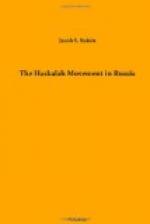Whether the Jews of Russia were originally pagans from the shores of the Black and Caspian Seas, converted to Judaism under the Khazars during the eighth century, or Palestinian exiles subjugated by their Slavonian conquerors and assimilated with them, it is indisputable that they inhabited what we know to-day as Russia long before the Varangian prince Rurik came, at the invitation of Scythian and Sarmatian savages, to lay the foundation of the Muscovite empire. In Feodosia there is a synagogue at least a thousand years old. The Greek inscription on a marble slab, dating back to 80-81 B.C.E., preserved in the Imperial Hermitage in St. Petersburg, makes it certain that they flourished in the Crimea before the destruction of the Temple. In a communication to the Russian Geographical Society, M. Pogodin makes the statement, that there still exist a synagogue and a cemetery in the Crimea that belong to the pre-Christian era. Some of the tombstones, bearing Jewish names, and decorated with the seven-branched Menorah, date back to 157 B.C.E.; while Chufut-Kale, also known as the Rock of the Jews (Sela’ ha-Yehudim), from the fortress supposed to have been built there by the Jews, would prove Jewish settlements to have been made there during the Babylonian or Persian captivity.[3]
Though the same antiquity cannot be established for other Jewish settlements, we know that Kiev, “the mother of Russian cities,” had many Jews long before the eighth century, who thus antedated the Russians as citizens. According to Joseph Hakohen they came there from Persia in 690, according to Malishevsky in 776. It is certain that their influence was felt as early as the latter part of the tenth century. The Russian Chronicles ascribed to Nestor relate that they endeavored, in 986, to induce Grand Duke Vladimir to accept their religion. They did not succeed as they had succeeded two centuries before with the khan of the Khazars.[4] Yet the grand duke, who had the greatest influence in introducing and spreading Greek Catholicism, and who is now worshipped as a saint, was always favorably disposed toward them.




